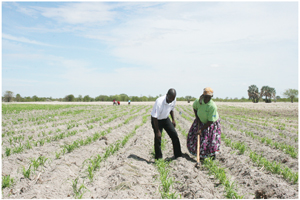
SADC cereal stocks sufficient for now but outlook is precarious

The food security situation in southern Africa has been subdued this year due to a lower harvest during the 2017/18 agricultural season.
According to a report on the State of Food and Nutrition Security and Vulnerability in Southern Africa published by the Southern African Development Community in July, dry spells that characterized the 2017/18 rainfall season resulted in reduced cereal harvests compared to the 2017 bumper crop that generated a surplus.
Based on the 10 SADC member states that provided cereal balance sheets for the 2018/19 marketing year, the region is estimated to have a cereal surplus of 6.3 million metric tonnes compared to 7.5 million tonnes for the same countries in the previous marketing year.
The countries that submitted their national vulnerability assessment reports are Botswana, Eswatini, Lesotho, Malawi, Mozambique, Namibia, South Africa, Tanzania, Zambia and Zimbabwe.
The reports revealed that only Mozambique and Tanzania experienced increases in cereal production during the 2017/18 farming season.
Production of maize and other cereal in Mozambique is estimated to have increased by 15% to 3.2 million tonnes in the 2017/18 agricultural season from 2.8 the previous season, while preliminary estimates for Tanzania put the output at 9.5 million tonnes for 2017/18 cropping season, up from 9.4 million tonnes previously.
Cereal production in South Africa, which usually accounts for the largest proportion of regional output, is estimated to have decreased by 19% during the 2017/18 season compared to the previous period, according to the report.
The largest drop in output was in Zambia where cereal production declined by 33% during the last agricultural season compared to 2016/17, while Zimbabwe experienced an 18% drop.
The impact of the lower than expected harvest on the region is, however, expected to be offset by significant carry-over stocks in South Africa, Zambia and Zimbabwe. South Africa is forecast to have opening maize stocks of over four million metric tonnes while Zambia and Zimbabwe are expected to have opening maize stocks of 900,000 tonnes each.
This means that carry-over stocks in these countries and expected surpluses in Mozambique and Tanzania will be enough to offset the deficits in Botswana, Eswatini, Lesotho and Namibia.
This will require SADC member states to take appropriate measures to promote trading of maize and avoid taking ad-hoc actions that would restrict imports or exports of grains within the region.
The region has in the past adopted several measures to mitigate the impacts of poor harvests. These include the promotion of investment in research and improved access to financial resources for smallholder farmers.
Other strategies are measures to strengthen capacity for the dissemination of research technologies to farmers, particularly smallholder farmers, who are the majority of farmers in the region. Access to such information is critical for planning purposes, especially when farmers want to diversify into new crops or livestock.
With regard to water infrastructure development, SADC is investing in irrigation to enable farmers to grow crops all year round and not only depend on climatic conditions.
The Water Sector Plan of the SADC Regional Infrastructure Development Master Plan contains a total of 34 infrastructure projects aimed at improving access to water in the region.
At the national level, various SADC member states are capacitating their farmers to embrace new technologies and ensure that they get increased productivity per unit area of land, rather than by increasing the area of cultivated land.
Individual countries are also improving their storage facilities to allow farmers to store their harvest for use in poor seasons.
Southern African News Features are produced by the Southern African Research and Documentation Centre (SARDC). Website and Virtual Library for Southern Africa at www.sardc.net










































